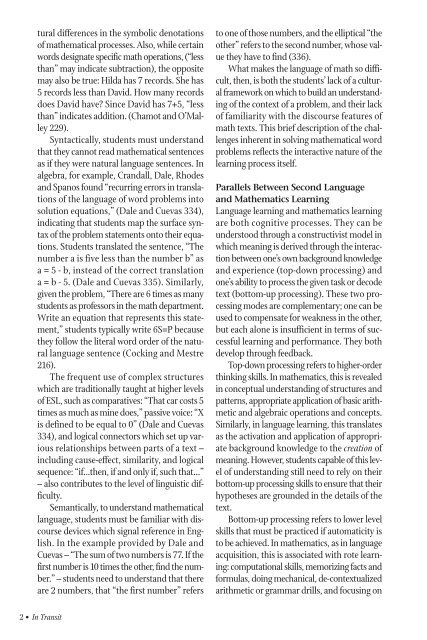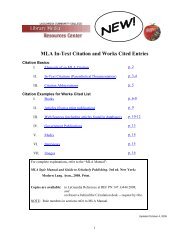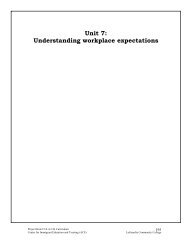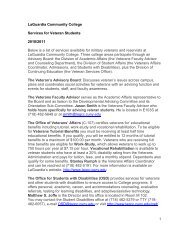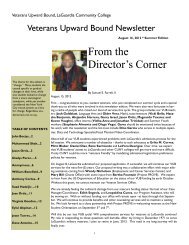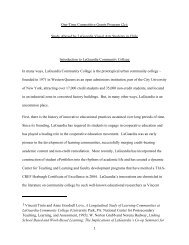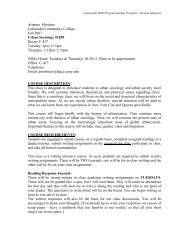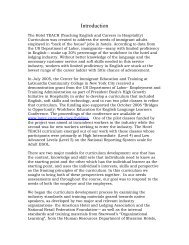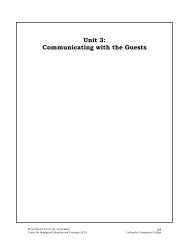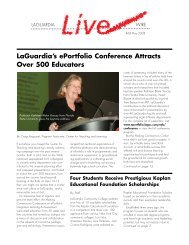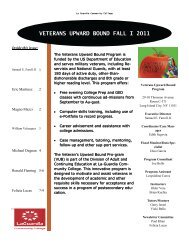Mathematics and ESL - Center for Teaching and Learning
Mathematics and ESL - Center for Teaching and Learning
Mathematics and ESL - Center for Teaching and Learning
You also want an ePaper? Increase the reach of your titles
YUMPU automatically turns print PDFs into web optimized ePapers that Google loves.
tural differences in the symbolic denotations<br />
of mathematical processes. Also, while certain<br />
words designate specific math operations, (“less<br />
than” may indicate subtraction), the opposite<br />
may also be true: Hilda has 7 records. She has<br />
5 records less than David. How many records<br />
does David have? Since David has 7+5, “less<br />
than” indicates addition. (Chamot <strong>and</strong> O’Malley<br />
229).<br />
Syntactically, students must underst<strong>and</strong><br />
that they cannot read mathematical sentences<br />
as if they were natural language sentences. In<br />
algebra, <strong>for</strong> example, Cr<strong>and</strong>all, Dale, Rhodes<br />
<strong>and</strong> Spanos found “recurring errors in translations<br />
of the language of word problems into<br />
solution equations,” (Dale <strong>and</strong> Cuevas 334),<br />
indicating that students map the surface syntax<br />
of the problem statements onto their equations.<br />
Students translated the sentence, “The<br />
number a is five less than the number b” as<br />
a = 5 - b, instead of the correct translation<br />
a = b - 5. (Dale <strong>and</strong> Cuevas 335). Similarly,<br />
given the problem, “There are 6 times as many<br />
students as professors in the math department.<br />
Write an equation that represents this statement,”<br />
students typically write 6S=P because<br />
they follow the literal word order of the natural<br />
language sentence (Cocking <strong>and</strong> Mestre<br />
216).<br />
The frequent use of complex structures<br />
which are traditionally taught at higher levels<br />
of <strong>ESL</strong>, such as comparatives: “That car costs 5<br />
times as much as mine does,” passive voice: “X<br />
is defined to be equal to 0” (Dale <strong>and</strong> Cuevas<br />
334), <strong>and</strong> logical connectors which set up various<br />
relationships between parts of a text –<br />
including cause-effect, similarity, <strong>and</strong> logical<br />
sequence: “if…then, if <strong>and</strong> only if, such that...”<br />
– also contributes to the level of linguistic difficulty.<br />
Semantically, to underst<strong>and</strong> mathematical<br />
language, students must be familiar with discourse<br />
devices which signal reference in English.<br />
In the example provided by Dale <strong>and</strong><br />
Cuevas – “The sum of two numbers is 77. If the<br />
first number is 10 times the other, find the number.”<br />
– students need to underst<strong>and</strong> that there<br />
are 2 numbers, that “the first number” refers<br />
to one of those numbers, <strong>and</strong> the elliptical “the<br />
other” refers to the second number, whose value<br />
they have to find (336).<br />
What makes the language of math so difficult,<br />
then, is both the students’ lack of a cultural<br />
framework on which to build an underst<strong>and</strong>ing<br />
of the context of a problem, <strong>and</strong> their lack<br />
of familiarity with the discourse features of<br />
math texts. This brief description of the challenges<br />
inherent in solving mathematical word<br />
problems reflects the interactive nature of the<br />
learning process itself.<br />
Parallels Between Second Language<br />
<strong>and</strong> <strong>Mathematics</strong> <strong>Learning</strong><br />
Language learning <strong>and</strong> mathematics learning<br />
are both cognitive processes. They can be<br />
understood through a constructivist model in<br />
which meaning is derived through the interaction<br />
between one’s own background knowledge<br />
<strong>and</strong> experience (top-down processing) <strong>and</strong><br />
one’s ability to process the given task or decode<br />
text (bottom-up processing). These two processing<br />
modes are complementary; one can be<br />
used to compensate <strong>for</strong> weakness in the other,<br />
but each alone is insufficient in terms of successful<br />
learning <strong>and</strong> per<strong>for</strong>mance. They both<br />
develop through feedback.<br />
Top-down processing refers to higher-order<br />
thinking skills. In mathematics, this is revealed<br />
in conceptual underst<strong>and</strong>ing of structures <strong>and</strong><br />
patterns, appropriate application of basic arithmetic<br />
<strong>and</strong> algebraic operations <strong>and</strong> concepts.<br />
Similarly, in language learning, this translates<br />
as the activation <strong>and</strong> application of appropriate<br />
background knowledge to the creation of<br />
meaning. However, students capable of this level<br />
of underst<strong>and</strong>ing still need to rely on their<br />
bottom-up processing skills to ensure that their<br />
hypotheses are grounded in the details of the<br />
text.<br />
Bottom-up processing refers to lower level<br />
skills that must be practiced if automaticity is<br />
to be achieved. In mathematics, as in language<br />
acquisition, this is associated with rote learning:<br />
computational skills, memorizing facts <strong>and</strong><br />
<strong>for</strong>mulas, doing mechanical, de-contextualized<br />
arithmetic or grammar drills, <strong>and</strong> focusing on<br />
2 • In Transit


